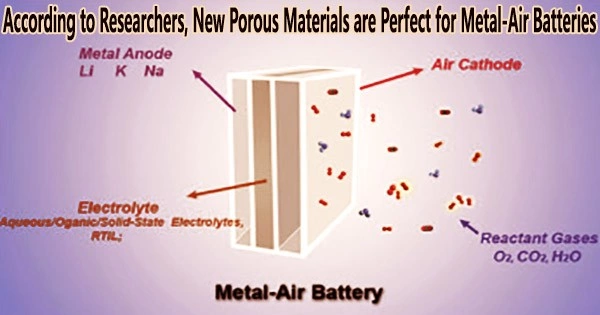It is impossible to create sustainable energy solutions out of thin air. According to a study team located in China, however, mixing air with metal and other frameworks may open the way for environmentally friendly energy conversion and storage.
In Nano Research Energy, they reviewed the potential of new porous materials known as metal-organic frameworks (MOFs) and covalent organic frameworks (COFs) to develop metal-air batteries.
The frameworks made of porous crystal materials contain different configurations of bound components that can produce desired features, such as the capacity to speed up reactions between oxygen and metals for converting and storing energy.
Its various configurations promote flexibility, and their high porosity and surface area give the required reactions the best possible chance to occur. Its derivatives, or items produced from the frameworks, also improve chemical stability and previously poor electrical conductivity.
But their advancement has been limited by inadequate conductivity and stability, according to co-corresponding author Tao Wang, professor, Centre for Hydrogenergy, College of Materials Science and Technology, Nanjing University of Aeronautics and Astronautics.
By comprehensively reviewing the advantages, challenges and prospects of MOFs and COFs, we hope that the organic framework materials will shed more profound insights into the development of electrocatalysis and energy storage in the future.
Professor Tao Wang
“Metal-air batteries, with high specific energy, moderate pricing, high safety and environmental friendliness, are the most promising candidate for energy storage and conversion,” Wang said. “At present, however, metal-air batteries involve a complex catalytic process of gas-liquid-solid phases, making it difficult to deeply understand the mechanism of discharge and recharge processes.”
In addition, Wang pointed out that some MOF and COF arrangements have sluggish reaction kinetics, necessitating the use of a powerful catalyst to both ease conversion difficulties and lengthen battery life.
The researchers read the most recent scientific literature to have a better understanding of how to manage the advantages and lessen the drawbacks of the frameworks and their derivatives.
They discovered, among other things, that the frameworks have a particular molecular structure that permits great porosity and uniform distribution of catalytic sites, making their reactions more predictable than with other porous materials.
“By systematically studying the effects between organic components and catalytic active centers of MOFs and COFs, we can gain a theoretical basis for us to select and synthesize the desired framework catalysts in the future,” Wang said. “We can also better understand the local microenvironment in MOFs and COFs and how it impacts the overall catalytic effect.”
Wang and the team advise more research into hybrid MOFs and COFs, the composition control and shape of MOF and COF derivates, as well as how to better create functionalized MOFs and COFs based on their reaction mechanisms.
In order to properly understand the relationship between the structure and the performance, they also advise creating more sophisticated techniques to detect the vibration signals of molecules on the electrode surface and watch the conversion process.
“By comprehensively reviewing the advantages, challenges and prospects of MOFs and COFs, we hope that the organic framework materials will shed more profound insights into the development of electrocatalysis and energy storage in the future,” Wang said.
















